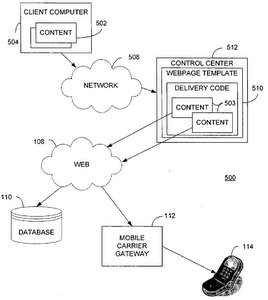CES 2012: SMS Patent for Sale, $60 million ONO
“Ever get a text message with a URL in it?” asked Robert Sanchez of a mostly empty room at the Consumer Electronics Show in Las Vegas on Monday. “That’s our patent.”

Two the cofounders of Sanchez’s company GlobalTel Mediafiled that patent in 2004, partly inspired by AOL. Sanchez was at CES to tell the world that tech giants including Twitter, Facebook and Apple are in his sights. He wants one of them to buy U.S. patent 8,073,895, known to its friends as “System and method for delivering web content to a mobile device,” off him.
“Someone’s infringing on us probably three to four million times a day,” said Sanchez, an entrepreneur and electrical engineer, at what was likely the worst-attended conference of press day at CES. While Samsung unveiled TVs, phones, and tablets three floors overhead, he spoke to an audience of less than 20 in a room at the Venetian Hotel and Casino. At least five people in the room were colleagues of Sanchez.
Patents have always been potent weapons in the technology industry but the last year has seen them used more aggressively—and lucratively—than ever before. Apple has used patents to seek import bans on competitor products, sometimes successfully, and Google paid $12.5 billion for Motorola Mobility last year to secure patents todefend itself and partners against such actions. Meanwhile, small companies that don’t sell technology products, such as Nathan Myrvold’s Intellectual Ventures, are criticized for using patents purely to extract license revenue from companies that do.

Intellectual Ventures and others with similar business models are often labeled “patent trolls”, but Sanchez insists that label doesn’t fit him. “I’ll simply sell it to the highest bidder,” he said of his patent, albeit on the condition of his own company receiving a permanent license to use the techniques detailed in the patent. Sanchez’ GlobalTel Media runs a site called Cherple that can be used to send text messages to phones in the U.S. and four other countries for free. Patent trolls don’t sell patents, says Sanchez, rather holding on to them to extract license fees for as long as possible.
When I asked what was a fair price, Sanchez said $60 million. “I would hope to close it by the end of February if it all goes right,” he said. Avoiding the question of whether he would sue to enforce the patent, Sanchez said anyone who checked would soon realize that they couldn’t get around it.
Sanchez previously helped lead work on cell phone network technology at mobile chip manufacturer Qualcomm and says that he is in talks with that company and “about” six others about buying his patent. Sanchez said he couldn’t name any of the other companies, although he did say that four of them are technology companies, and are two device manufacturers. He expected to discuss his patent with “the world’s largest search company” later in the week at CES, he said.
Such success in attracting the attention of potential bidders seemed, to me, at odds with the need to run a press conference. Sanchez simply said “I’ve never done this before, it’s an experiment.”
If that experiment works (and yes, I’m a part of it), the results will likely be strident accusations of two kinds: that Sanchez is a patent troll and that the USPTO allows patenting of things that it shouldn’t. Meanwhile, Sanchez says he is getting ready for round two, having recently been issued a patent for payments made between mobile devices. “We were offered several millions for that one even before it was issued,” he said.
Keep Reading
Most Popular
Large language models can do jaw-dropping things. But nobody knows exactly why.
And that's a problem. Figuring it out is one of the biggest scientific puzzles of our time and a crucial step towards controlling more powerful future models.
How scientists traced a mysterious covid case back to six toilets
When wastewater surveillance turns into a hunt for a single infected individual, the ethics get tricky.
The problem with plug-in hybrids? Their drivers.
Plug-in hybrids are often sold as a transition to EVs, but new data from Europe shows we’re still underestimating the emissions they produce.
Stay connected
Get the latest updates from
MIT Technology Review
Discover special offers, top stories, upcoming events, and more.